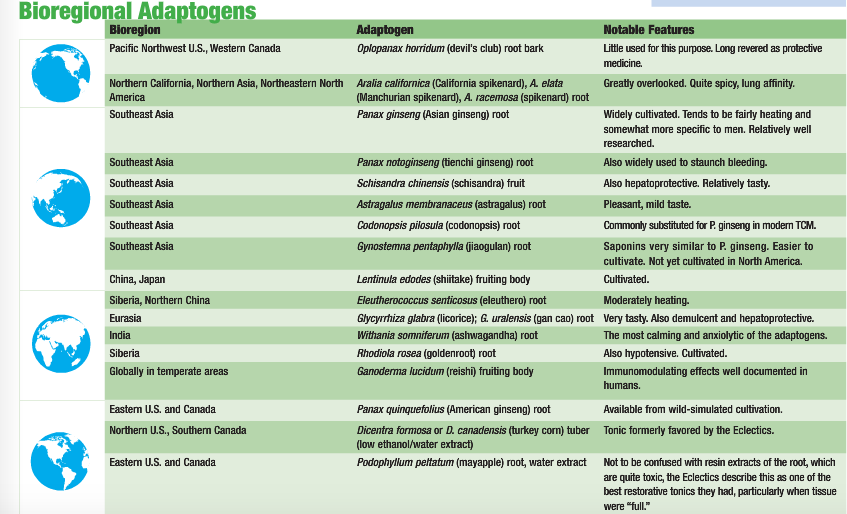Eric Yarnell, ND, RH(AHG)
Adaptogens, or safe herbs that help patients cope with stress, occupy a place of prominence in herbal medicine. Stress is a major factor in creating mind-body illness, and adaptogens are a useful part of correcting imbalances. Naturopathic physicians are generally familiar with the common adaptogens and many prescribe them routinely. However, many adaptogens are frequently overlooked, particularly in the face of the latest faddish adaptogen to become popular, which right now is indisputably Rhodiola rosea. This article will attempt to deepen and broaden prescribing of adaptogen herbs while addressing the ecological dimensions of botanical medicine, rather than simply promoting the latest, hottest product (whether it offers any benefits over existing choices).
Bioregional Adaptogen Choice
Global trade in medicinal herbs, with the associated use of fossil fuels to transport them, is a serious problem. Similarly, harvest pressure placed on distant wild populations in regions of the world with nonfunctional or corrupt government systems could contribute to extermination of the very herbs we want to use. With so many adaptogens to choose from, we must place ecological considerations above clinical issues to have a truly sustainable medical system. The easiest way to reduce the burden on the planet is to choose adaptogens from local sources. See the two tables below for choosing amongst various adaptogens.
Clinical Distinctions Between Adaptogens
Sometimes, however, certain patient characteristics may call for use of one adaptogen over another, trumping the environmental issues. In such circumstances, it is recommended that a bioregional adaptogen or adaptogens be tried first, as they may well work anyway, given the generalized supportive actions of all these herbs. Only if this fails should one resort to using adaptogens that do not necessarily come from, or were not grown in, one’s own bioregion.
For example, patients with significant liver dysfunction may well need either Glycyrrhiza spp. or Schisandra chinensis. These are the two adaptogens most specifically for supporting the liver.
For very hot patients with insomnia, anxiety, or who are otherwise high energy, the most cooling and calming adaptogen is Withania somniferum. Luckily this valuable and very distinctive adaptogen is coming into wider cultivation in the United States, making for a more ecofriendly source of it for people in North America.
Patients with strong taste aversions will likely do best with Glycyrrhiza spp., Astragalus membranaceus, or one of the medicinal mushrooms.
Anytime one is thinking of using Panax spp., consider Codonopsis, Gynostemna, or Platycodon grandiflorum (balloon flower) root as more sustainable alternatives, particularly because they are more readily and flexibly grown in a wider variety of regions. Otherwise, the next section talks about four North American adaptogens not really being widely used that deserve more attention.
Four Overlooked Adaptogens
Oplopanax horridum (devil’s club) root bark is perhaps best known as a remedy for diabetes mellitus patients. However, diabetes was not common in Native Americans before the European conquest, and this usage is really only very recent. Instead, it was seen traditionally more as a protective plant, in line with its incredible spines, and was given to people with rheumatism or other body aches, chronic infections such as tuberculosis, and to enhance endurance. All adaptogens seem to have benefits in people with diabetes, doubtless, but devil’s club is a much broader herb than this. It is much cooler than Panax or Eleutherococcus, but is still somewhat stimulating. The dose of tincture (30% ethanol) or glycerite is 3-5 ml tid.
The widely distributed Aralia spp. (spikenard) genus is underused. It is a very hot, spicy member of the Araliaceae family and has similar saponin constituents as others in the family. A cursory search of the medical literature quickly reveals a substantial body of research on the Eurasian species, documenting adaptogenic, insulin sensitizing, antineoplastic, immunomodulating, and many other actions. Its definite stimulating expectorant activity will help loosen and move mucus from the lungs in chronic pulmonary conditions. A typical dose of tincture (30% ethanol) is 3-5 ml tid.
Dicentra spp. (turkey corn) was formerly much revered by the Eclectic physicians. The alkaloids in this species can be quite intense, emphasized by its close relationship to Corydalis spp. It particularly tends to restore digestion chronically impaired by stress. It can also have a moderate analgesic effect. Low doses of tincture (30% ethanol), usually prepared in an alkaline menstruum to limit alkaloid extraction, no more than 1 ml tid, are generally used. Higher alkaloid products are used primarily as antineoplastics and are not as tonifying.
Podophyllum peltatum (mayapple), like turkey corn, is also used as an aqueous extract or low-ethanol tincture, as an adaptogen or tonic. Higher ethanol extracts or crude root contains resins, and the notorious podophyllotoxin lignan mixture has a distinctive cathartic laxative effect and is potently anticancer and antiviral. These strong, druglike effects are not those desired for relieving stress. Instead, the low-resin extracts only mildly stimulate the bowels, and tend to lead to improved digestion overall. The Eclectics repeatedly emphasize that it is most effective in patients with sluggish digestion, flabby tongues, chronic disease due to toxin accumulation from the gut, fatigue, and fullness of tissues. The usual dose of tincture (30% ethanol) is 5-10 gtt tid. If a cathartic action occurs, reduce the dose. The use of this herb should be monitored carefully and should not be given to anyone with significant gastrointestinal inflammation to limit absorption of any resin.
Overall, these adaptogens should be used more and will lead to continued success remedying the negative effects of chronic, uncompensated stress while simultaneously decreasing environmental problems arising from modern globalization of herbal medicine.
References
Felter HW: Eclectic Materia Medica, Pharmacology and Therapeutics, Sandy, OR, 1922, Eclectic Medical Publications (reprinted 1998).
Kari PR: Dena’ina K’et’una (Tanaina Plantlore), Anchorage, AK, 1977, Adult Literacy Lab.
Turner NC, Bell MAM: The ethnobotany of the Southern Kwakiutl Indians of British Columbia, Econ Botany 27:278, 1973.
 Eric Yarnell, ND, RH is a graduate of Bastyr University. He completed a two-year residency with Silena Heron, ND, and served as chair of botanical medicine at SCNM. He is past senior editor of the Journal of Naturopathic Medicine. Dr. Yarnell is a founding member and current president of the Botanical Medicine Academy and author of numerous textbooks and articles, including Naturopathic Urology and Men’s Health, Naturopathic Gastroenterology and Clinical Botanical Medicine. His area of clinical focus is urology and men’s health. He is assistant professor in botanical medicine at Bastyr University.
Eric Yarnell, ND, RH is a graduate of Bastyr University. He completed a two-year residency with Silena Heron, ND, and served as chair of botanical medicine at SCNM. He is past senior editor of the Journal of Naturopathic Medicine. Dr. Yarnell is a founding member and current president of the Botanical Medicine Academy and author of numerous textbooks and articles, including Naturopathic Urology and Men’s Health, Naturopathic Gastroenterology and Clinical Botanical Medicine. His area of clinical focus is urology and men’s health. He is assistant professor in botanical medicine at Bastyr University.


